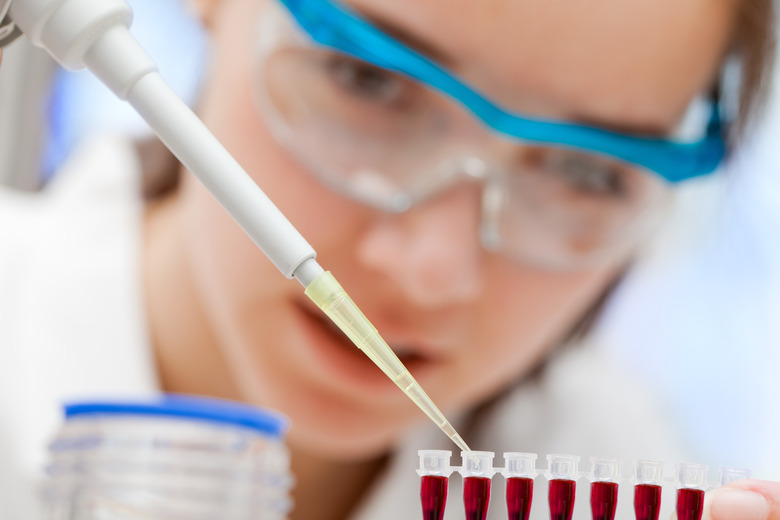Steps Of DNA Transcription
Transcription is the biochemical process of transferring the information in a DNA sequence to an RNA molecule. The RNA molecule can be the final product, or in the case of messenger RNA (mRNA), it can be used in the process of translation to produce proteins. RNA Polymerase is a protein complex that performs the main job of reading a DNA template and synthesizing RNA, but accessory proteins are also needed.
TL;DR (Too Long; Didn't Read)
Transcription has three major phases: Initiation, elongation and termination.
Initiation
Initiation
Just before initiation, RNA polymerase and accessory proteins bind to a DNA molecule upstream of the initiation point. The DNA is unwound to separate and expose the strand to be transcribed. Then, the RNA polymerase complex binds to a promoter sequence, which establishes initiation of transcription. Polymerase begins to synthesize a strand of RNA complementary to one side of the DNA strand, moving into the coding sequence portion of the gene being transcribed.
Elongation
Elongation
During elongation, a lengthening RNA molecule is produced by DNA polymerase as it reads the DNA triplet code on the template strand. The polymerase will continue reading the template until it reaches a sequence that provides a signal indicating that transcribed region is at an end. Another RNA polymerase can attach to the promoter to begin synthesizing another RNA before the first one is finished.
Termination
Termination
Termination of transcription is triggered when the RNA polymerase encounters a particular DNA sequence, causing the polymerase to lose affinity for the DNA template. At this point, RNA polymerase disengages from the DNA and the RNA molecule is released for translation or post-transcriptional processing.
Transcription Factors
Transcription Factors
Other proteins besides RNA polymerase are required for transcription. These proteins are called transcription factors. They may bind to RNA polymerase, interact with other transcription factors, or bind to DNA directly to affect transcription. Transcription factors are required for proper assembly of the initiation complex, and have important functions in elongation and termination.
Regulation of Transcription
Regulation of Transcription
The efficiency and degree to which transcription occurs is regulated by the aforementioned transcription factors as well as DNA binding proteins. Suppressor proteins attach to DNA to block initiation, preventing certain genes from being transcribed. Other molecules can interact with suppressors, causing them to leave their DNA binding sites, allowing transcription to proceed.
Eukaryotic and Prokaryotic Transcription
Eukaryotic and Prokaryotic Transcription
The different cell organization and complexities of eukaryotes and prokaryotes make for some significant differences in transcription. Transcription occurs in the nucleus in eukaryotes and in the cytoplasm in prokaryotes (since they have no nucleus). Eukaryotic mRNA is post-transcriptionally modified with a 3-foot poly-A tail and 5-foot cap. Eukaryotic RNA often contains non-protein coding sections called introns, which are removed after transcription. No such modifications are made in prokaryotes. Prokaryotic transcription requires fewer proteins than eukaryotic transcription.
Cite This Article
MLA
McIntosh, Philip. "Steps Of DNA Transcription" sciencing.com, https://www.sciencing.com/steps-dna-transcription-2455/. 23 April 2018.
APA
McIntosh, Philip. (2018, April 23). Steps Of DNA Transcription. sciencing.com. Retrieved from https://www.sciencing.com/steps-dna-transcription-2455/
Chicago
McIntosh, Philip. Steps Of DNA Transcription last modified August 30, 2022. https://www.sciencing.com/steps-dna-transcription-2455/
